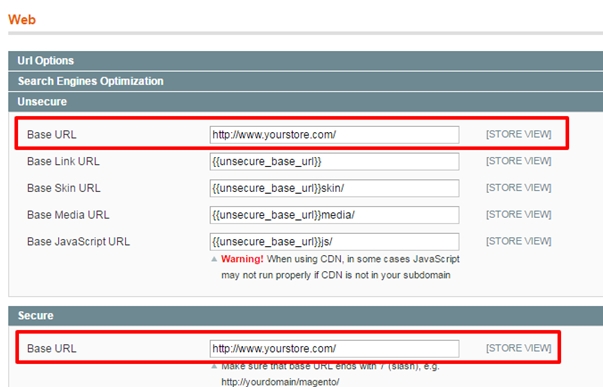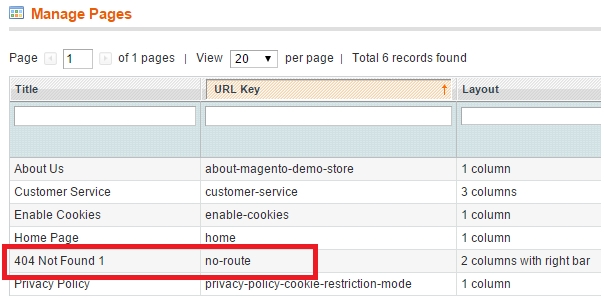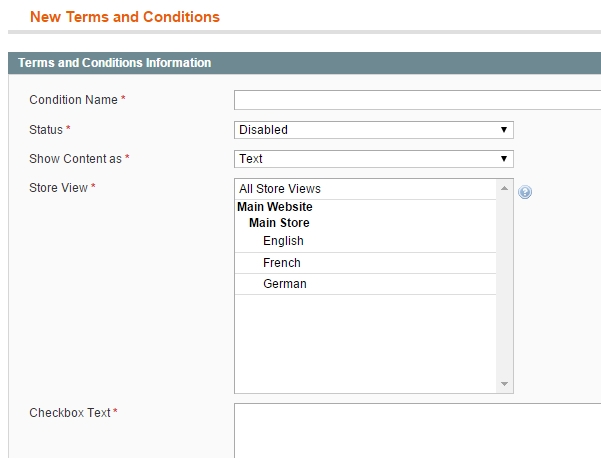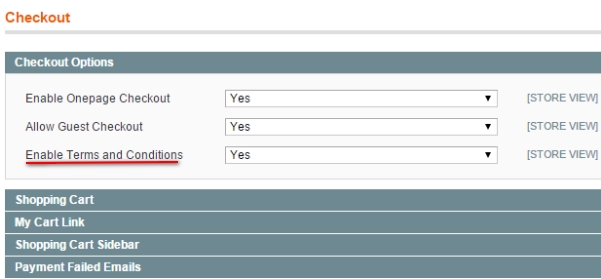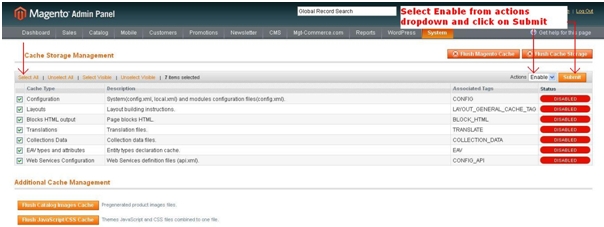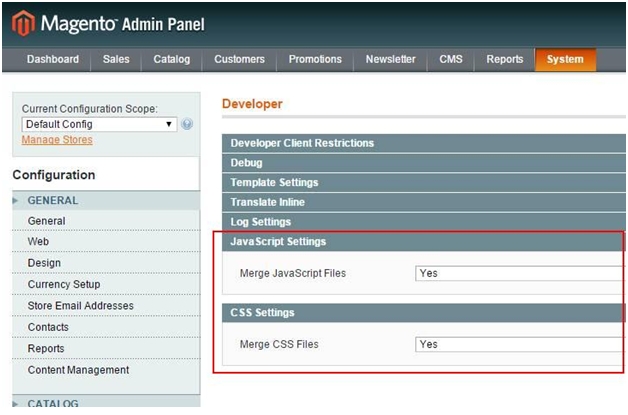After spending days and months building wonderful functionalities on the Magento website, It is very important for Magento developers to make sure that the webshop launch process goes smoothly. You may be an impression that you have covered everything required for a great launch but in the back of your mind, there might be things that you miss out on.
Here We’ve got you a great pre-launch checklist compiled by our dedicated Magento developer. Use it before launching any of your Magento websites.
Basic Configuration
- Store URLs
Make sure that your store’s base URLs are correct for your live site launch. Confirm that your Magento website has appropriate URLs on all your stores set up. You can check them here in Magento Admin: System -> Configuration -> Web.
- Security Certificate
It’s always good to make your customers feel secure using your website. Purchase a Security Certificate from a trusted SSL provider and make sure that it is configured properly with your server and Magento store.
- Favicon
Generally, website owners often forget to upload favicons on new websites. This helps in the user experience and visual branding of the website.

See How Our Experts Can Drive More Traffic to Your Website!
SEO: Boost your rankings and drive more organic traffic today!
Website Design/Development: Create a stunning website that converts visitors into customers.
Paid Media: Reach the right audience at the right time with expertly managed paid media.
- HTML Head
This information is crucial when launching the site. Update all the info to help with your SEO. Set the ‘Title’, and set Meta descriptions and keywords from the path in Admin: System -> Configuration -> General -> Design.
- Placeholder Images
These images are the default images used by Magento to show a symbol of Magento on the category and products where you have not uploaded any images for your catalog. For the purpose of branding, you can create a set of your own placeholder images and upload it by going to the path in Admin: System -> Configuration -> Catalog -> Product Image Placeholders.
- Contact Information
Make sure that all the store information and email addresses are set up to the correct ones so that if any customer tries to connect with you, you can get in touch with them. You can find those in Admin paths: System -> Configuration -> General -> Contacts.
System -> Configuration -> General -> Store Email Addresses -> General Contact.
- Copyright
In the footer, there is a place for copyright information which is always shown on all the pages. Make sure that your copyright information is updated. You can do that in Admin here: System -> Configuration -> General -> Design -> Footer -> Copyright.
- Store Email Addresses
Ensure that all your business email addresses are correctly set up. You can check them from Admin path: System -> Configuration -> General -> Store Email Addresses.
- Error Page Design
This page is shown to customers in front of the website when there is an error on site. You must keep a 404 Not Found page and design it to match your website theme. You can also create a different approach and create another layout or design to entertain your customers if they are thrown to this page. You can set up this page in Admin from CMS ->Pages ->Search for the “404 not found” page.
SEO Configuration
- Email Templates
The emails which are being sent to your customers make quite an impact on your store’s user experience and SEO. Make sure that all the email templates are designed to match your website’s theme and have a user-friendly layout.
- Newsletter
Ensure that store’s newsletter subscription functionality is working fine so that customers can subscribe to receive your newsletters. Newsletters are a very efficient way to attract new and old customers to your website with weekly updates or new offers for regular shopping. You can check its configuration here in admin area: System -> Configuration -> Customers -> Newsletter -> Subscription Options.
- Invoices and Packing Slips
Make sure that these slips are set up with all the required information of order and that your store logo is set up correctly for website branding.
- Google Analytics
Stay updated with your website’s traffic updates by integrating Google Analytics with your Magento store. Magento provides default functionality to easily integrate your existing account by entering your analytics account ID in the path: System -> Configuration -> Sales -> Google API -> Google Analytics.
- Google Sitemap
All search engine crawlers get your store’s catalog information from sitemap files. Magento provides you the functionality to create Google Sitemap which helps in SERP rankings. You can generate the sitemap by simply going to this path: Catalog -> Google Sitemap -> Add a new sitemap.
Sales Configuration
- Cart Options
Make sure that all the sections on your cart page are working fine. Magento provides Shipping Estimate and Discount coupon codes section on the cart page for a better customer shopping experience. There are also cart rules and minimum order amount restrictions applied here. Please check all of them are correct as per your business model.
- Checkout Options
You can set the option for guest checkout and also point out your store’s terms & conditions so that your customers are aware of that information in case of any doubts they may have.
- Tax Settings
Check these configurations to make sure that tax is applied properly to the store as they are set up. You can find those at: System -> Configuration -> Sales -> Tax -> Tax Classes -> Tax Class for shipping.
- Shipping Methods
Ensure that shipping options visible to customers are applied correctly and they have correct prices as per your shipping logic-based weights or order amount. You can check your store’s shipping settings from:System -> Configuration -> Sales -> Shipping Settings.
Also, the shipping methods can be setup from: System -> Configuration -> Sales -> Shipping Methods.
- Payment Methods
Before launching the site to production, test the payment gateways to make sure your website processes the payments properly and restrictions applied for currency and countries. You can check your store’s payment settings from: System -> Configuration -> Sales -> Payment Methods.
Legal Pages
- Privacy Policies
Many countries require that your websites provide information such as privacy policy so that your customers can know about the legal process company follows and what information is stored from customers. This can be a CMS page with all the information.
- Terms & Conditions
If your store has specific terms and conditions for customers to place orders on your website then you have to provide that information so that customers can agree to your conditions before making any purchase. You can add it from the path: Sales -> Terms and Conditions -> Add New Condition.
Also, to show this on checkout you need to Enable Terms and Conditions from this path: System -> Configuration -> Sales -> Checkout.
- Return Policies
If your store offers the facility for returning purchased merchandise for customers then it would be good practice to provide information on the rules required to be followed. This can be a simple CMS page with all the information about your return policy.
Performance & Optimization Configuration
- Index Management
Ensure that your store’s indexes are updated before launching the site to production. Magento provides Index Management for a faster process of catalog information. There are many types of indexes added in the Magento but make sure all are marked with Ready status in green color. If an index is in red then you have to Re-index it to get your store updated with the latest changes. You can find the configuration here: System -> Index Management.
- Cache Management
Magento provides the default functionality of caching to improve your website’s performance on the customer’s end. There is an additional Full Page Cache also introduced by Magento for better HTML and resource caching. Ensure that all the cache is enabled before you launch the website. You can find all cache configurations here at path: System -> Cache Management.
- System Compilation
Magento provides a feature to get better performance by running the compilation process. Basically what it does is store all the files of Magento which are required to run your store on the browser in one place and loads it from there instead of using the general Magento framework structure. This reduces the time of searching for each file in the structure and results in better performance.
To use this feature go to Admin -> Tools -> Compilation -> click on Run Compilation Process.
This will result in an error if any of your extensions are conflicting or your server does not have sufficient space.
- Log Cleaning
It’s good practice to keep your logs clean because sometimes it can cause performance issues on your server and database. Magento generally cleans logs after 180 days but if your store is generating a few small errors from a code perspective then that log files can grow to be of very much large sizes. The same can happen with your database if your website is getting heavy traffics which results in huge logs in the database.
To clean the logs up manually go to Admin -> System -> Configuration -> Advanced -> System -> Logs tab -> Change “Save Logs, Days” to 15 or your preferred time -> Save config.
You can also clean up your logs from the database if you have phpMyAdmin access by running the following queries.
- Minify CSS & JS
Magento stores having too many design files and scripts can result in slow loading speed. For this, you need to make sure that your website theme is optimized. You can improve speed and performance by merging all the CSS into one or two files and doing the same for Javascript.Go to Admin -> System -> Advanced -> Developer.
Under “JavaScript Settings” and “CSS Settings” change the dropdown to “Yes” and click on “Save Config.”
Clear your Magento cache after it to reflect the changes on the website front pages.
If your theme is a complex one and uses many jQuery plugins then merging JavaScript may break your layout or many functionalities of your website. If that happens then it would be best to leave it unmerged.
Cron Schedule
There are many processes that are required to run periodically at specific times in Magento such as email, catalog price rules, newsletters, customer alerts, Google sitemaps, update currency rates, etc. To configure it go to the path in admin: System -> Configuration -> Advanced -> System and modify the Cron.php file in the root of your Magento store file system.
Launch
Now you are ready to deploy your Magento website to production.
Moving ahead, for any type of maintenance work or edits – You should have 2 versions of your website. First is a live website that your customers are using to order and the second is the staging site which you use for any new functionality development or design changes, and move to live after thorough testing so that live site operations do not get disturbed.
Keep taking backup of your store on a regular basis so in case of any hiccups you have the last working copy of the website to restore the site and keep your sales on track.
It’s always good to have regular contact with a great Magento eCommerce development company to assist you on all the points listed above.


